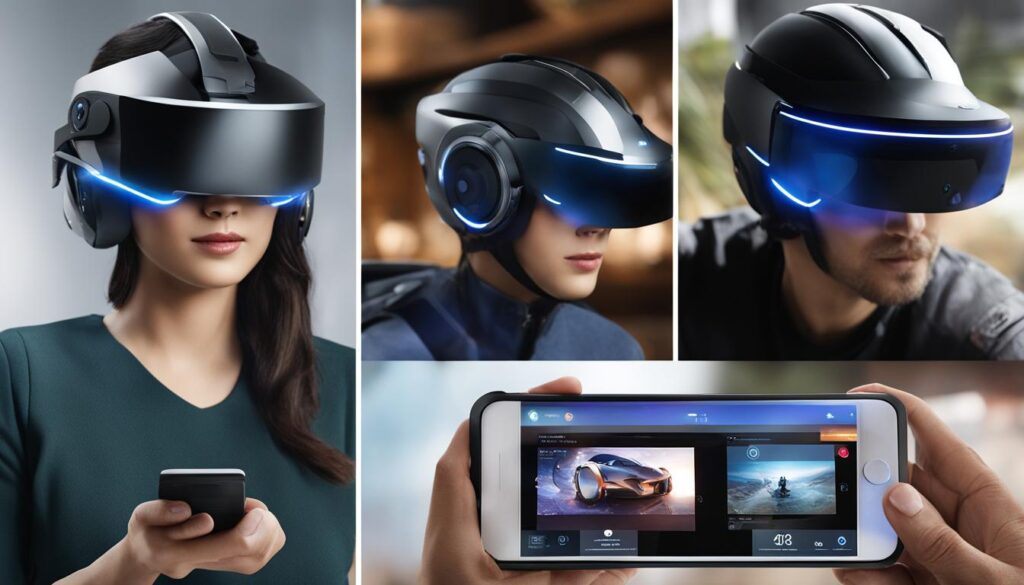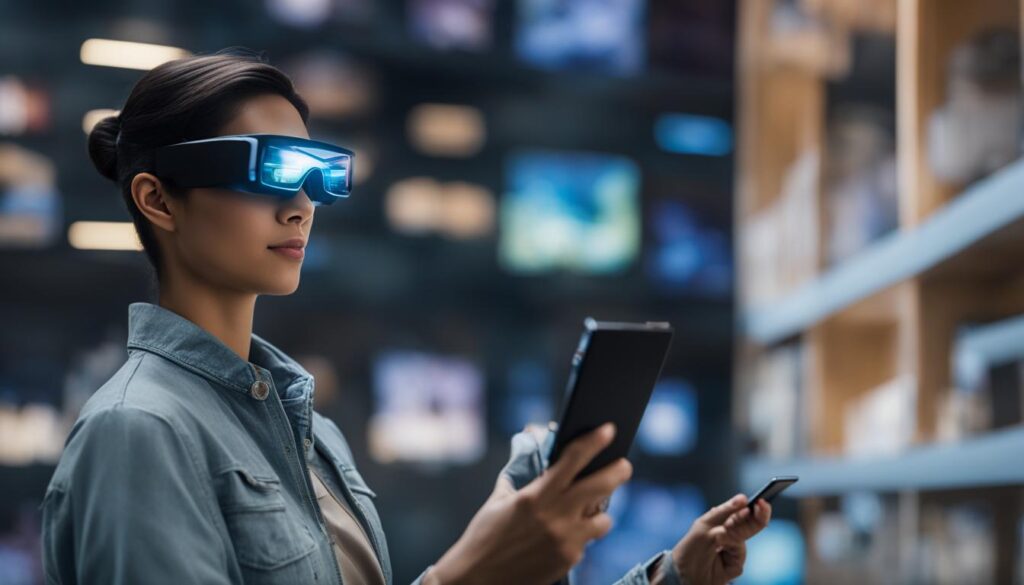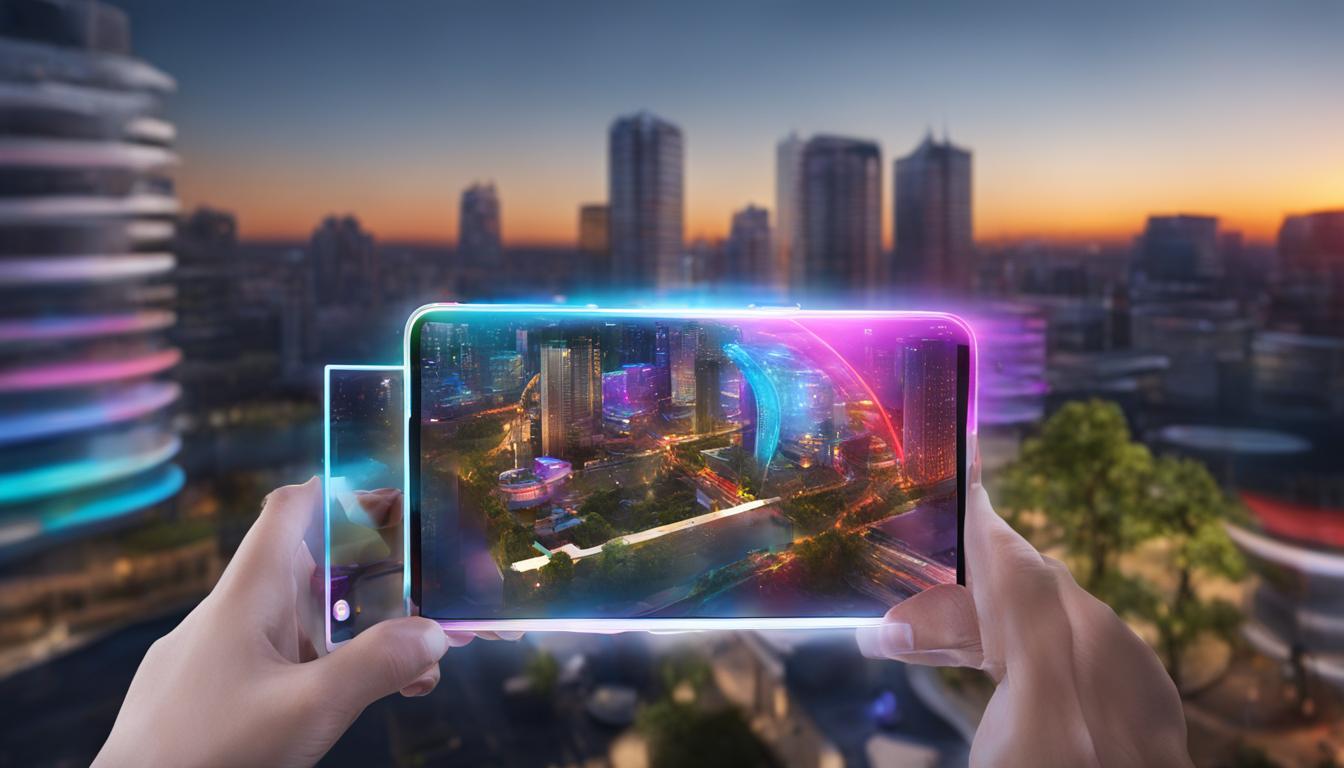Augmented reality (AR) has revolutionized various industries, providing immersive and interactive experiences like never before. If you’re eager to join the AR revolution, having the right tools at your disposal is crucial.
This article will explore the best tools for creating augmented reality experiences and delve into the top 10 AR development platforms to consider.
Creating AR experiences requires specialized software and development tools specifically designed for augmented reality. These tools enable developers to build interactive AR applications, whether it’s for education, entertainment, or any other industry.
From AR creation software to virtual reality content creation tools, the market offers developers and creators a wide range of options. By carefully considering these tools’ features, capabilities, and compatibility, you can select the one that best aligns with your project requirements and expertise.
In the next section, we will explore different types of augmented reality applications and understand how they function. This knowledge will help you better understand the tool most suits your specific AR project.
Contents
- 1 Types of Augmented Reality Applications
- 2 10 Best Augmented Reality Tools to Consider
- 3 Advancements in Augmented Reality Technology
- 4 Conclusion
- 5 FAQ
- 5.1 What tools are used to create augmented reality?
- 5.2 What are the different types of augmented reality applications?
- 5.3 What are the best-augmented reality tools to consider?
- 5.4 What advancements have been made in augmented reality technology?
- 5.5 What are the benefits of using augmented reality development tools?
- 6 Source Links
Key Takeaways:
- AR development tools are essential for creating immersive augmented reality experiences.
- There are various types of AR applications, including marker-based, GPS-based, gyroscope-based, and SLAM apps.
- Choosing the right AR development platform depends on your project requirements and expertise.
- Some popular AR development tools include Vuforia, Wikitude, ARKit, ARCore, and Unity.
- Advancements in AR technology have made it possible to create realistic AR experiences without relying on trigger images.
Types of Augmented Reality Applications
Augmented reality applications can be categorized based on their functionality. There are different AR-based apps, including marker-based, GPS-based, gyroscope-based, and SLAM (Simultaneous Localization and Mapping) apps. Let’s explore each type in detail:
1. Marker-Based Apps
Marker-based apps rely on recognizing specific markers, such as QR codes or physical objects, to overlay virtual content onto the real-world environment. Users can interact with augmented elements by scanning the markers and accessing additional information.
2. GPS-Based Apps
GPS-based apps use GPS data to determine the user’s location and provide location-specific AR experiences. These apps can display information, such as nearby places of interest, directions, or user-generated content based on the user’s geographical coordinates.
3. Gyroscope-Based Apps
Gyroscope-based apps utilize the gyroscope sensor in smartphones to augment virtual objects in the real-world environment. By tracking the orientation and movement of the device, these apps create interactive and immersive AR experiences that respond to the user’s physical interactions.
4. SLAM Apps
SLAM apps leverage multiple sensors, including GPS, gyroscope, and accelerometer, to create realistic AR experiences without relying on specific markers.
These apps can detect the 3D geometry of the surrounding environment and overlay virtual content seamlessly, allowing for a more immersive and intuitive AR interaction.
Each type of augmented reality application offers unique possibilities and experiences. Developers can choose the most suitable type based on the specific requirements of their projects.
Now that you better understand the different types of AR applications, let’s explore the top AR development tools in the next section.
Also read: Can You Visit Other Countries with Augmented Reality?
References:
“Augmented Reality: Where Are We Now and What the Future Holds”
10 Best Augmented Reality Tools to Consider
The right tools are crucial when creating immersive augmented reality (AR) experiences. With a plethora of options available, here are the top 10 AR development tools that you should consider:
- Vuforia: Vuforia is a popular AR SDK with robust tracking and recognition capabilities. It supports various platforms and devices, making it a versatile choice for AR development.
- Wikitude: Wikitude is another powerful AR SDK known for its markerless tracking and geolocation-based AR features. You can create AR experiences seamlessly, blending virtual content with the natural world with Wikitude.
- ARKit: Developed by Apple, ARKit is a framework that allows developers to build AR apps for iOS devices. It provides advanced features like environment understanding and motion tracking, enabling realistic AR experiences on Apple devices.
- ARCore: ARCore, Google’s AR platform, offers similar capabilities to ARKit but is optimized for Android devices. It supports motion tracking, environmental understanding, and light estimation, making it a powerful Android AR app development tool.
- MaxST: MaxST is an AR SDK that specializes in marker-based tracking. It provides accurate and stable marker recognition, making it ideal for applications that heavily rely on markers for AR content.
- Spark AR Studio: Spark AR Studio is a widely-used AR tool for creating augmented reality experiences on Facebook and Instagram. It offers a user-friendly interface and a wide range of effects and filters to enhance your AR creations.
- Unity: Unity is a popular game development engine supporting AR development. It provides comprehensive tools and features to create highly interactive and visually stunning AR applications.
- Echo3D: Echo3D is a cloud-based AR platform that simplifies creating and deploying AR content. It allows you to manage and update your AR experiences in real time, making it ideal for dynamic AR applications.
- 8th Wall: The 8th Wall offers a developer-friendly framework for building WebAR experiences. With 8th Wall, you can create AR applications that run directly in web browsers, eliminating users’ need to download dedicated AR apps.
- Kudan: Kudan is an AR SDK focusing on SLAM (Simultaneous Localization and Mapping) technology. It enables precise tracking and mapping of the environment, making it suitable for AR applications that require accurate spatial understanding.
These AR development tools provide many features and capabilities to bring your AR ideas to life. Choose the tool that best aligns with your project requirements and dive into the exciting world of augmented reality.
Also read: Augmented Reality Surgery Training Uses

Advancements in Augmented Reality Technology
Augmented reality (AR) technology has made significant progress in recent years, revolutionizing how we interact with the digital world. One of the most notable advancements is the ability to create AR experiences without needing a trigger image.
Traditional AR applications relied on specific markers to initiate virtual overlays. However, with new technology, such as ARKit and ARCore, surface tracking has become the key to seamlessly integrating AR content into the real world.
Surface tracking allows AR applications to detect and track flat surfaces, such as floors, tables, or walls. By understanding the dimensions and lighting conditions of the environment, ARKit and ARCore can accurately place virtual objects on these surfaces, enhancing the overall immersion and realism of the experience.
This advancement in AR technology eliminates the reliance on trigger images and opens up a new realm of possibilities for interactive and dynamic AR applications.
While trigger image-based AR experiences are still prevalent, especially in educational settings, the adoption of surface tracking technology is steadily increasing. The shift towards surface tracking enables developers to create more engaging and interactive AR applications that seamlessly blend virtual content with the real world.
Also read: Is a Cars Heads Up Display Augmented Reality?
The Benefits of AR Surface Tracking
AR surface tracking offers several key benefits:
- Enhanced User Experience: By accurately placing virtual objects on natural surfaces, AR surface tracking creates a more realistic and immersive experience for users.
- Improved Interaction: With the ability to recognize and track surfaces, users can interact with AR objects more naturally, enabling innovative applications in gaming, design, and spatial computing.
- Expanded Use Cases: Surface tracking technology opens up opportunities for AR applications in various industries, including retail, architecture, entertainment, and more.
- Accessible Development: With ARKit and ARCore providing surface tracking capabilities, developers can access powerful tools that simplify the creation of surface-aware AR experiences.
Examples of AR Surface Tracking in Action
AR surface tracking has been implemented in a wide range of applications, showcasing the versatility and potential of this technology:
| Application | Description |
|---|---|
| E-commerce1 | Customers can visualize furniture or home decor products in their own space by placing virtual objects on surfaces, allowing them to make informed purchasing decisions. |
| Interior Design2 | Design professionals can superimpose virtual furniture or decorative items onto actual surfaces, enabling clients to preview and approve designs before implementation. |
| Education3 | Teachers can create interactive lessons where virtual models or diagrams are placed on surfaces, enhancing student engagement and understanding. |
These examples demonstrate the practical applications of AR surface tracking across various industries and the potential to create unique and impactful user experiences.
With the advancements in augmented reality technology, particularly surface tracking, the possibilities for innovative AR applications are expanding rapidly. As AR continues to evolve, we can anticipate even more exciting developments that will revolutionize how we interact with the digital world.

Conclusion
Augmented reality (AR) has revolutionized how we create immersive digital experiences. With advancements in AR technology, developers now have a vast array of expanded reality development tools and software development kits (SDKs) to choose from for AR app development.
Whether you’re looking to create market-based solutions, incorporate surface tracking capabilities, or leverage cloud-based platforms, options are available to suit your needs.
By utilizing the best AR development tools, you can unleash your creativity and bring your ideas to life in the AR realm. These tools provide the necessary features and functionalities to seamlessly integrate virtual objects into the real world, delivering captivating and interactive experiences.
From Vuforia and Wikitude to ARKit and ARCore, various tools cater to different aspects of AR app creation.
Embark on your augmented reality journey and elevate your digital experiences with the right tools. Explore the possibilities of AR app development and embrace the transformative power of this technology.
With the right combination of vision, creativity, and the best-augmented reality development tools, your imagination is the limit. Start building your own immersive AR experiences and captivate users like never before.
FAQ
What tools are used to create augmented reality?
Top tools used to create augmented reality experiences include Vuforia, Wikitude, ARKit, ARCore, MaxST, Spark AR Studio, Unity, Echo3D, 8th Wall, Kudan, ARToolKit, and Blender.
What are the different types of augmented reality applications?
There are different types of augmented reality applications, including marker-based apps, GPS-based apps, gyroscope-based apps, and SLAM (Simultaneous Localization and Mapping) apps. Marker-based apps rely on recognizing specific markers, GPS-based apps use GPS data to determine the user’s location, gyroscope-based apps utilize the gyroscope sensor in smartphones, and SLAM apps leverage multiple sensors to create realistic AR experiences without markers.
What are the best-augmented reality tools to consider?
Some of the best augmented reality tools to consider include Vuforia, Wikitude, ARKit, ARCore, MaxST, Spark AR Studio, Unity, Echo3D, 8th Wall, Kudan, ARToolKit, and Blender.
What advancements have been made in augmented reality technology?
One notable advancement in augmented reality technology is creating AR experiences without relying on a trigger image. Newer AR technology, such as ARKit and ARCore, utilizes surface tracking to place virtual objects in the real world based on the environment’s dimensions and lighting conditions.
What are the benefits of using augmented reality development tools?
Augmented reality development tools allow developers to create immersive AR experiences and bring their ideas to life. These tools provide market-based solutions, surface tracking capabilities, cloud-based platforms, and more to enhance the development process and elevate digital experiences.




